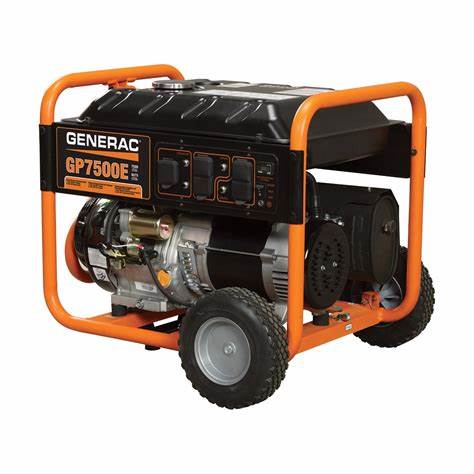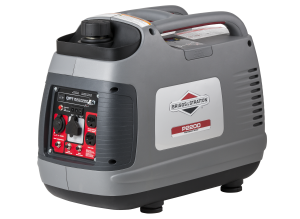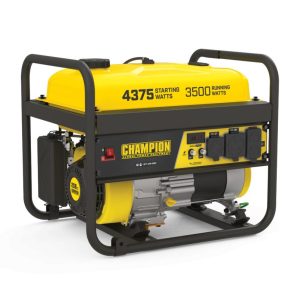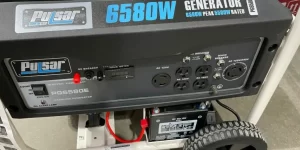12 Causes of a Dying Generator (Troubleshoot)
When it first started, your generator ran smoothly, but now it keeps turning off.
When a generator kicks on but quickly dies, it could be because of a number of issues, including a lack of fuel, a clogged fuel filter, a dirty carburetor, a clogged fuel line, a malfunctioning gas cap, a dirty spark plug, a faulty ignition coil, low engine oil, and old gas.
First, let the engine cool down completely, and then disconnect the spark plug wire. Always observe all safety measures outlined in your generator’s manual.

Affiliate links are used in this post. If you make a purchase after clicking one of these links, we may receive a small commission. We are an Amazon Associates program and get a small percentage of sales that meet certain criteria.
Before diagnosing, repairing, or operating your equipment, be sure you’ve read and understood any relevant safety information found in the equipment’s operator’s manual.
Table of Contents
Your Generator Starts and Stops
Generator’s Gas Tank is Empty
A generator that runs on gas will not function without gas. Since you seem frustrated, it’s possible that you didn’t even think to examine this simple cause.
If your fuel use is more than typical, you may have a fuel leak. The fuel gauge could be broken, fooling you into thinking you have enough of gas when in fact you don’t. Restore functionality to any malfunctioning components.
One way to prevent this is to avoid using a stool or other uneven surface to set up the generator. When the generator’s fuel level drops dangerously low, or it runs out entirely, additional fuel must be added.
Using Outdated Generator Fuel
It doesn’t matter whether there’s plenty of gas in the tank; stale gas can limit fuel flow and damage engine parts.
As early as 30 days after purchase, gas might start to degrade. Ethanol is now a common additive in gasoline. This is an alternate fuel that can cause fuel system corrosion by attracting moisture.
Separating from the fuel, water and ethanol will settle to the bottom of the storage container. The fuel system and the engine are both severely weakened by this combination.
The residue it leaves behind, called varnish, clogs the fuel system and prevents the engine from receiving the necessary amount of fuel.
For optimal safety, gasoline should be used within 30 days of purchase. Since you don’t typically use a generator, it’s tough to predict how much gas you’ll need in this time period.
This is why you should always mix a fuel additive with new gas before putting it in the tank. When added to gas, a fuel stabilizer like Sea Foam Motor Treatment helps keep gas fresher for longer by drawing out excess moisture.
To get the most out of your fuel, try following these guidelines:
- Unleaded gasoline having an octane value of 87 or above and no more than 10% ethanol can be used in 4-cycle generators.
- Don’t fill up with gas that has a high ethanol percentage. Try to avoid combining with oil.
- Two-stroke generators necessitate a gas and fuel combination. Combine high-quality 2-cycle air-cooled engine oil with unleaded gasoline that has an octane value of at least 87 and no more than 10% ethanol.
- Make sure to use your gas within the next 30 days.
- Don’t store gasoline in the open.
- Gasoline should be kept in a cool, dry place.
- Do not stock up on more gasoline than you can use within a month. Extra gas should have a fuel stabilizer added if you plan on keeping it for an extended period of time.
The ANSWER is to transfer the used gas to a disposal container. To stabilize and clean the fuel system, use new fuel with a fuel additive.
Generator With a Clogged Fuel Filter
A filter is commonly found in the fuel tank of portable generators. This filtration method is not readily available.
A fuel filter installed inline between the fuel lines is used by certain other generators to remove debris from the fuel supply before it reaches the carburetor. It serves to prevent foreign matter, such as dirt and debris, from entering the fuel system.
Filter buildup from dirt can prevent fuel from getting past it. Without enough fuel, the engine could die.
One way to solve this problem is to use fuel hose pinch pliers or the fuel shut-off valve to completely halt fuel flow to the inline fuel filter. Take off the old gasoline filter and swap it out with a brand new one. Restart the gas supply by turning the valve back on.
If your fuel tank has a filter installed at the bottom, you’ll need to drain the tank’s contents before you can access the filter for replacement.
Generator Fuel Line Clog
Gummy deposits left behind by old gas can clog fuel lines. This reduces the diameter of the fuel line, preventing fuel from reaching the carburetor.
Check the flow rate of fuel leaving a specific segment of the fuel line by opening and closing the fuel shut-off valve.
The gasoline line must be disconnected from the generator in order to spray carburetor cleaning into the line and break up the obstruction.
The next step is to use compressed air to blow through the line and dislodge the obstruction. Use as often as required.
Line installation must be repeated. If you are unable to remove the clog or discover that your gasoline lines are dry and broken, a replacement fuel line can be acquired at an auto parts store or hardware store.
An Issue with a Generator’s Fuel Pump
It is not necessary to use a fuel pump with the vast majority of portable generators. However, a fuel pump is required in some models of generators whose carburetor is mounted higher than the fuel tank.
The fuel in the tank is pumped to the carburetor by a vacuum fuel pump, which draws suction from the engine. The generator will stop working if the fuel pump fails to supply gas to the carburetor.
Make sure fuel is reaching the fuel pump’s input port before you start testing the pump. Then, store the carburetor line in a suitable container after removing it.
Turn the key and keep an eye on the line to see if the flow is constant or pulsing.
If your fuel pump is intermittently supplying fuel to the carburetor, you should replace it.
Poorly Maintained Generator With A Filthy Carburetor
The carburetor is the part of the engine that combines the fuel with the combustion air.
Deposits left by old gas can clog fuel lines and stick internal carburetor parts. If this happens, the generator’s engine may run out of gas and shut down.
Clean your carburetor to get rid of the crusty buildup and sticky deposits left behind from using old fuel or fuel containing ethanol. It may be necessary to rebuild or replace your carburetor if it is too dusty or if some of its parts are broken.
Problems with a Generator Due to an Incorrect Choke Setting
If you want to start a generator with a cold engine, you have to close the choke. To keep the engine running after it has warmed up, the choke must be moved to its open position.
If your engine fires up but immediately dies, checking that the choke is open could be the answer.
Generator With A Clogged Air Filter
In order to prevent engine wear caused by dirt entering the air intake, an air filter is required. Due to its significance, this component requires regular maintenance checks.
Typically, a home’s air filter should be cleaned a few times a year and replaced once a year. If the filter appears to be severely soiled or broken, it should be replaced immediately.
Using the generator in dry, dusty circumstances will significantly increase the frequency with which it must be replaced.
The engine will not have enough air to function properly if the filter is not periodically cleaned and replaced. It poses a serious risk of engine overheating, which can result in costly repairs.
If you discover that your air filter is clogged, you can clean it by following the steps outlined below.
Cleaning recommendations for air filters will vary depending on the brand, so always consult your owner’s handbook.
Faulty Gas Cap or Fuel Tank Vent
Any gasoline storage system worth its salt will include a vent that allows air to flow in and out of the tank to maintain a constant pressure inside.
Filling the tank with air will cause it to explode if the vent is blocked while the fuel is being used. A vacuum will be created in the tank, preventing fuel from reaching the carburetor. The result is that the generator will be disabled.
With a pressure gauge, you can find out if the fuel tank vent is the source of the issue. If you don’t have a pressure gauge, you needn’t worry.
To find out if there’s a problem with the vents, try this:
- Turn the gas cap loose.
- Turn on the backup power. If the generator is working properly, you can try to recreate the problem by loosening and then tightening the fuel cap.
- To find out if the generator slows down or stops working altogether, let it run for a while longer.
- The gasoline tank vent is broken if the engine misbehaves and loses power until you release the cap and let air into the tank.
Often, gas caps double as vents for gasoline tanks. There could be a separate vent on top of the fuel tank as well.
If you discover that your fuel tank is no longer venting properly, the solution is to either replace the gas cap or the rollover valve.
A Generator With A Grimy Spark Plug
The spark plug was responsible for creating the spark that kicked off the engine, so if it’s unclean or damaged, the generator can sputter and die.
Resolve: Check the spark plug’s condition by removing it. You should get a new spark plug if the tip is very black, the electrode is worn, or the porcelain is cracked.
Once you’ve determined that the spark plug is in working order, you’ll want to clean it with a wire brush, check the electrode gap, and then connect the spark plug wire. An improper spark plug gap or a dangling wire might potentially stop the generator from functioning.
Damaged Ignition Coil in a Generator
Ensure the spark plug is in good working order before you start troubleshooting the ignition coil. The engine cannot be started without the ignition coil sending voltage to the spark plug.
A malfunctioning spark plug or faulty ignition coil will prevent the engine from starting.
SOLUTION: Make sure the ignition coil has continuity. If a break in continuity is detected, the ignition coil must be replaced.
A Generator With Low Oil Pressure
Your generator could be running for a time and then shut down unexpectedly. See if the warning light for low oil has come on.
It’s possible that your generator has a sensor that turns it off when the oil gets too low, saving you from having to replace an expensive engine. It won’t turn back on until the oil level in the engine is fixed.
The fact that it won’t keep running may be infuriating. And yet, it’s excellent news that the generator has turned off.
If you’re low on oil and you keep driving, you could do serious damage to your engine from the increased friction. When the engine gets too hot, the components can melt.
FIRST, set the generator down on a level place so you can check the oil level. To drain the oil, unscrew the oil fill cap and wipe the dipstick dry with a clean towel.
Drop the dipstick back into the oil filler tube without replacing the cap. Take the dipstick out and check the oil level. Make sure it’s within the full range of the dipstick.
If it isn’t, you should adjust the engine oil level by taking out or putting in some air-cooled engine oil.
If you check the engine oil and it is at the proper level, but the low oil sensor continues to light up, you may have a defective sensor. The generator should be taken to a service center for maintenance.







